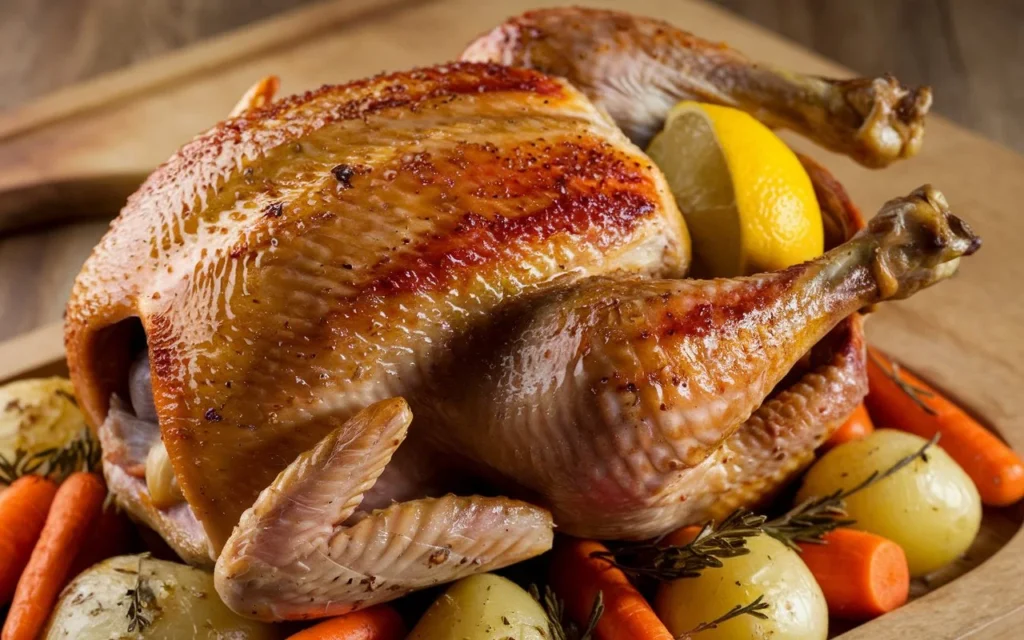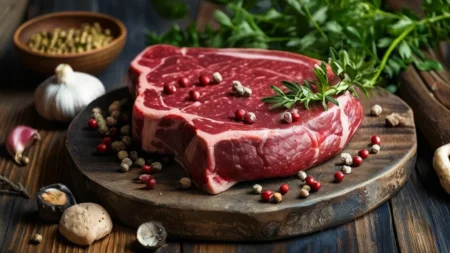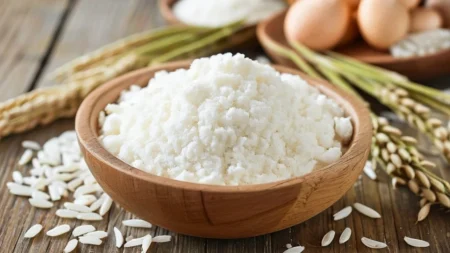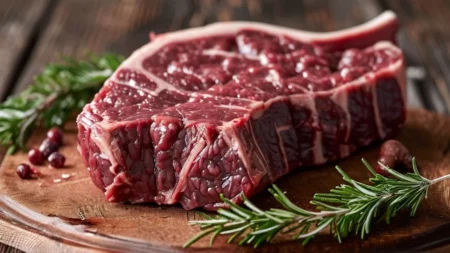Chicken: Nutrition, Health Benefits, and Recipes
Key Takeaways:
- Chicken is a lean source of high-quality protein, providing essential vitamins and minerals such as B vitamins and selenium.
- It supports muscle growth, immune health, and is a versatile ingredient in many cuisines.
- Chicken is low in fat, especially when skinless, and can be incorporated into a balanced diet with various cooking methods like grilling, baking, or boiling.

What is Chicken?
Chicken is one of the most popular and widely consumed meats worldwide, praised for its versatility, mild flavor, and nutritional benefits. It comes from domesticated chickens, and different cuts of the bird, such as breasts, thighs, wings, and drumsticks, offer varying textures and flavors. Chicken can be prepared in countless ways, making it a staple in many global cuisines.
Nutritional Breakdown per 3 Ounces (85 grams) of Cooked, Skinless Chicken Breast
| Nutrient | Amount |
|---|---|
| Calories | 165 kcal |
| Protein | 31 grams |
| Fat | 3.6 grams |
| Saturated Fat | 1 gram |
| Carbohydrates | 0 grams |
| Vitamin B6 | 0.5 mg (25% DV) |
| Selenium | 22.4 mcg (32% DV) |
Health Benefits of Chicken
Chicken is not only delicious but also packed with important nutrients that contribute to various health benefits, especially when it is part of a balanced diet.
1. High in Protein for Muscle Growth
Chicken, especially the breast, is an excellent source of high-quality protein, which is essential for building and repairing muscle tissue. Protein helps support muscle growth, making chicken a popular choice for athletes and individuals looking to maintain a healthy, lean body mass.
2. Supports Immune Function
Chicken contains important vitamins and minerals like vitamin B6, selenium, and zinc, which are vital for immune health. Selenium, in particular, has antioxidant properties that help reduce inflammation and protect the body from oxidative damage.
3. Low in Fat and Calories
Chicken breast, when cooked without the skin, is low in fat and calories, making it an excellent option for those who are managing their weight or trying to reduce their fat intake. It provides high-quality protein without excessive saturated fats found in red meats.
4. Rich in Essential Vitamins and Minerals
Chicken is a good source of several important nutrients, including B vitamins (such as niacin and B6), phosphorus, and selenium. These nutrients help support energy production, brain function, and overall cell health.
Different Cuts of Chicken
Each part of the chicken has different nutritional values, flavors, and uses. Here’s a breakdown of the most common cuts:
1. Chicken Breast
Chicken breast is the leanest part of the chicken, making it a great option for those looking for a high-protein, low-fat meat. It’s ideal for grilling, baking, or stir-frying.
2. Chicken Thighs
Chicken thighs are higher in fat than breasts, which gives them a richer, juicier flavor. They are commonly used in slow-cooked dishes, curries, and roasted meals.
3. Chicken Wings
Chicken wings are popular for appetizers and finger foods. They have a higher fat content but are delicious when baked or fried, often served with a variety of sauces.
4. Chicken Drumsticks
Drumsticks are another flavorful, cost-effective cut. They are perfect for grilling or roasting and are commonly used in family meals and barbecues.
How to Incorporate Chicken Into a Healthy Diet
Chicken’s versatility makes it easy to include in a well-rounded diet. It can be prepared in numerous ways to suit different dietary needs.
1. Grilled Chicken for a Lean Option
Grilling chicken is one of the healthiest ways to prepare it, as it requires minimal added fats and helps retain the protein content. Grilled chicken breast pairs well with vegetables, whole grains, and salads.
2. Baked Chicken for a Heart-Healthy Meal
Baking chicken is another healthy cooking method that doesn’t require much oil or butter. You can add herbs and spices for flavor while keeping the fat content low.
3. Chicken Soup for Immune Support
Chicken soup is a traditional remedy for colds and flu. The broth made from chicken bones contains nutrients like collagen and amino acids that can support immune health and reduce inflammation.
Chicken in Different Cuisines
Chicken is a staple protein in many global cuisines, each with unique methods of preparation and flavor profiles.
1. American Cuisine
In American cuisine, chicken is commonly grilled, fried, or roasted. Popular dishes include fried chicken, chicken tenders, and buffalo wings.
2. Indian Cuisine
Indian cuisine is known for its rich, flavorful chicken dishes such as chicken tikka, butter chicken, and chicken curry. Spices like turmeric, cumin, and coriander are often used to enhance the flavor.
3. Mediterranean Cuisine
Chicken is widely used in Mediterranean dishes, often grilled and served with fresh vegetables, olive oil, and whole grains like quinoa or couscous. Dishes like chicken shawarma and souvlaki are popular in this region.
Chicken vs. Other Proteins
While chicken is a popular protein source, it’s often compared to other meats and plant-based proteins. Here’s how chicken stacks up:
1. Chicken vs. Beef
Chicken is lower in fat and calories than beef, especially when consumed skinless. It’s also a better option for those looking to reduce their intake of saturated fats. However, beef provides more iron and vitamin B12.
2. Chicken vs. Fish
Fish, particularly fatty fish like salmon, contains more omega-3 fatty acids, which are beneficial for heart health. However, chicken is more versatile and widely available, making it easier to incorporate into daily meals.
Potential Downsides of Chicken
While chicken is generally a healthy food, there are a few considerations to keep in mind when adding it to your diet.
1. Antibiotics and Hormones
Conventionally raised chickens are often given antibiotics and hormones to promote growth and prevent disease. Opting for organic or free-range chicken can help minimize your exposure to these substances.
2. Risk of Overcooking
Chicken, especially breasts, can dry out easily if overcooked. It’s important to monitor cooking times and use a meat thermometer to ensure that chicken is cooked to a safe internal temperature of 165°F without becoming tough or dry.
Conclusion
Chicken is a highly nutritious, versatile, and affordable source of protein. Whether you’re grilling, baking, or adding it to soups and salads, chicken can fit into a variety of diets and meal plans. With its high protein content, low fat, and essential nutrients, chicken supports muscle growth, immune health, and overall wellness. Just be mindful of the quality of chicken you buy and the cooking methods you use to maximize its health benefits.
FAQ
Q: How long can cooked chicken be stored in the fridge?
A: Cooked chicken can be stored in the refrigerator for 3 to 4 days. Make sure to keep it in an airtight container to prevent contamination.
Q: Is chicken a good option for weight loss?
A: Yes, chicken is an excellent option for weight loss, especially lean cuts like chicken breast. It’s high in protein and low in fat, which helps promote satiety and reduce overall calorie intake.
Q: Can chicken be eaten raw?
A: No, eating raw or undercooked chicken poses a risk of foodborne illnesses, such as salmonella. Always cook chicken to an internal temperature of 165°F to ensure it’s safe to eat.
Q: What’s the best way to thaw frozen chicken?
A: The best way to thaw chicken is in the refrigerator overnight. You can also thaw it in cold water or use the defrost setting on your microwave, but avoid thawing it at room temperature.
Q: Is dark meat chicken less healthy than white meat?
A: Dark meat (like thighs and drumsticks) is higher in fat and calories than white meat (like breasts), but it’s also richer in certain nutrients, such as iron and zinc. Both cuts can be part of a healthy diet when consumed in moderation.










